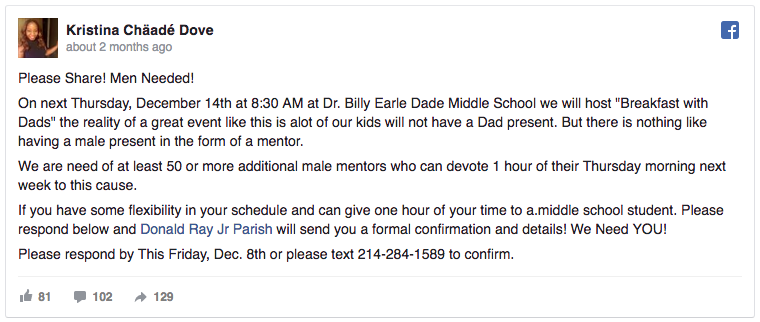 If you regularly read my blog and web site materials or have seen me present, then you know just how strongly I believe in the importance of the involvement of volunteers in nonprofit/mission-based causes. I believe that volunteer engagement represents community investment, can allow people from different walks of life to be associated with a cause more deeply than just donating money, can allow people who don’t want to or cannot quit their day jobs to be involved in a cause, educates people about a cause through firsthand experiences, and can demonstrate the organization’s transparency regarding decision-making and administration. Service activities can educate volunteers to be better advocates for a cause, even change their behavior or feelings regarding certain issues, activities and groups. And I believe any of these reasons are far, far better reasons for involving volunteers than to save money by not paying staff.
If you regularly read my blog and web site materials or have seen me present, then you know just how strongly I believe in the importance of the involvement of volunteers in nonprofit/mission-based causes. I believe that volunteer engagement represents community investment, can allow people from different walks of life to be associated with a cause more deeply than just donating money, can allow people who don’t want to or cannot quit their day jobs to be involved in a cause, educates people about a cause through firsthand experiences, and can demonstrate the organization’s transparency regarding decision-making and administration. Service activities can educate volunteers to be better advocates for a cause, even change their behavior or feelings regarding certain issues, activities and groups. And I believe any of these reasons are far, far better reasons for involving volunteers than to save money by not paying staff.
I feel so strongly about the importance of volunteer engagement that when I see nonprofit organizations that don’t involve volunteers in some way, it makes me suspicious of them – how invested is this organization in the community it’s supposed to serve if it isn’t letting the community participate behind-the-scenes? How much does this organization really want to be a part of the community if the only way I can be a part of that organization is to work for it, professionally?
But I also have to say that I am wary of the value of a lot of volunteer activities, much more so now, having worked for international humanitarian aid and development agencies for more than 15 years. I regularly witness or hear about volunteering activities abroad and right here in the USA that are more about making the givers of service feel good than about benefitting the cause that the organization is supposed to serve. Voluntourism gets accused of this a lot: people going for a week or two to a poor community, usually in another country, and doing things that local people would love to do themselves, and be paid to do themselves, like build wells, build schools, repair houses, play with orphans, teach a few English classes, etc. Do those activities primarily benefit local people or a critical cause, or are they actually more about being great money-makers for organizations, including religious groups, that know Westerners will pay big bucks for a feel-good volunteering experience and lots of touching photos of them in exotic or devastated locations? There are even tragic consequences from this kind of volunteering, such as the rise of orphan voluntourism, where children that are NOT orphans are presented as such, in need of help from short-term international volunteers, people with little or no expertise regarding the needs of at-risk children.
An article from December 2015 in Cracked captured my wariness about some volunteering, particularly around the holidays. It’s called “5 Realities Of A Homeless Shelter At Christmas.” Regarding homeless shelters, the article notes:
These charities exist to help people with serious problems. They do not exist to round up sideshows and parade them around for gawkers, or to help regular folks gain perspective on their own lives. Surprisingly, not everyone is aware of this.
The article also notes:
Remember, these people are homeless for a reason. We don’t mean “because they’re jerks and deserve it”; we mean that mental illness and substance abuse issues run rampant. If you reserve your charitable feelings only for those capable of showing gratitude in some satisfying way, you’ll be neglecting the ones who need help the most. They show their gratitude by still being alive the next time Christmas comes around.
This all came to mind recently when I found an article about a young boy who created his own nonprofit so he, personally, could hand out food to homeless people in the city where he lives. That’s the primary purpose of the nonprofit: to give him an outlet to hand out food to homeless people. He’s well under age, so I’m not going to name him or his nonprofit or say where he is – I also really do not want to humiliate a kid, especially one that has such a big heart. But his nonprofit seems to be more about him than the homeless: the nonprofit has his name in the title, the web site for the organization is filled with many, many more photos of him than homeless people, and on the web site, a link for more information doesn’t say “About our organization,” but rather, “About me.”
He says he started his nonprofit because organizations serving the homeless turned him away as a volunteer because he’s “too young to help,” and that made him “sad.” What I suspect shelters and food kitchens actually said is that many of their clients are not allowed, legally, to be around anyone under 18, and the organization would, therefore, be causing those people to break the law by interacting with a child. They probably also told him that shelter staff need to put their resources into helping clients, not diverting such to ensuring the safety and heart-warming learning experience of underage volunteers.
The web site for this child’s organization has no information about the nutritional needs of the homeless or statistics on food availability for the homeless in this particular city. The web site has no information about the causes of homelessness. The aforementioned Cracked article correctly points out that when homeless people die, it’s most often from heart disease, substance abuse and trauma, rarely from hunger, although, of course, nutrition is a big challenge and hardship for many homeless people. The principle causes of food insecurity in the United States are unemployment, high housing costs, low wages and poverty, lack of access to SNAP (food stamps), and medical or health costs, but the web site for this child’s nonprofit never mentions any of these realities – it makes it sounds like he’s personally keeping these folks alive, that most homeless people die of starvation. Even if his nonprofit isn’t going to address any of those causes of hunger, shouldn’t those causes be mentioned somewhere on his site? This young man’s nonprofit could make a HUGE difference by helping people, particularly young people, understand why people are homeless, why they experience food insecurity – and they could take that knowledge to the ballot box, and make donation decisions based on that knowledge. Instead, this nonprofit, as demonstrated by the web site and by the media coverage of the nonprofit, is about making a little boy feel like he’s making a difference in the world, and making us feel good about him.
Robert Lupton, a veteran community activist based in Atlanta and author of Toxic Charity: How the Church Hurts Those They Help and How to Reverse It, was quoted in an opinion piece in The Atlanta Journal-Constitution, saying this about various volunteer groups that show up to hand out food in Atlanta parks: “The folks that come and hand out sandwiches? I call that harmful charity. It’s irresponsible… Who is this service activity for? To help the homeless? Or someone else?” I am not as down on charity as Lupton; in contrast to him, I do believe charity and aid will always be needed, that food banks and on-the-street food handout programs cannot and should not be replaced entirely by community development / empowerment / teach-a-man-to-fish programs, and I think there are very good things that can come from group volunteering projects in communities . But I do agree with him that a lot of high-profile volunteering seems more about making the giver have a feel-good experience and lots of great photos than focusing on the primary needs of those to be served.
No one is too young to volunteer, but there are volunteering activities in which a youth or child may NOT participate, because it would be illegal or inappropriate. Even with that restriction, there is no cause a young person can’t support in some meaningful way as a volunteer, including helping the homeless, and there are many ways a young person can volunteer, no matter how young he or she is. Volunteering is a great way to teach children about compassion and empathy, but it shouldn’t perpetuate old-fashioned ideas about volunteering, that it’s just about charity, and that its primary purpose is about well-off people giving food and items to poor people, but not talking about why there are poor people and not addressing those reasons. Volunteering by youth shouldn’t be primarily about making the kids feel good about themselves. Volunteering by youth should educate those young people about why causes are important, about community challenges, and/or about people very different from themselves. And volunteering should ALWAYS be primarily about what the person or cause needs most, not about the volunteers themselves. That means sometimes telling well-meaning people, even young people, “It’s great that you want to help, but the way you want to help is not what’s needed most and, in fact, can take valuable resources away from what we really need. And what we really need is…”
This is not a call for a volunteer motivation “purity” test. Volunteering doesn’t have to be selfless – as I have said many times in my workshops, I’m a part of Generation X, and I’ve never volunteered “to be nice” in my entire life; I’ve volunteered because I’m angry about a situation and want to do something about it, because I’m lonely or bored, because I want to explore careers, because I’m curious about an organization or activity, because I want to develop a skill or get experience for my résumé, because it sounds fun, because I want the fabulous t-shirt, and on and on. Almost any reason to volunteer is a great reason to volunteer. What I’m questioning are some of the reasons volunteering activities are created – what I’m saying is that they may actually do harm rather than good.
Even with all my disclaimers and all my work to date promoting volunteerism, I have a feeling this blog is still going to get me accused of being anti-volunteer. Nothing could be farther from the truth. But vanity volunteering… sorry, I’m just not a fan.
For more on this subject – written by others:
Symptoms of a Vanity Nonprofit by Mark Fulop, from May 28, 2014.
The Most Outlandish Charity Trends: Is It About Vanity?, from MainStreet an online financial magazine & news site by TheStreet, in April 2014.
Vanity Charity, an opinion piece by Alan Cantor, published online on March 5, 2013
This 2012 Cracked article: “5 Popular Forms of Charity (That Aren’t Helping).
This New York Times Magazine article, “The Vanity of Volunteerism,” from July 2000.
#InstagrammingAfrica: The Narcissism of Global Voluntourism , from the Pacific Standard, June 2014
This Boston Globe article, Corporate volunteers can be a burden for nonprofits, from March 2015
How to judge a charity: the five questions no one asked Kids Company (How do you know if a charity is changing lives?), 2 January 2016 article from The Spectator
Added Jan. 18: In The Reductive Seduction of Other People’s Problems, Courtney Martin warns against a line of thinking which leads privileged young Westerners to think they can solve serious social problems in developing countries. Ms. Martin points to failed international development efforts like the now-infamous PlayPump, a piece of playground equipment that was meant to also pump underground water in remote communities. It was embraced by the development community — though the pumps didn’t, in fact, work. “It’s dangerous for the people whose problems you’ve mistakenly diagnosed as easily solvable. There is real fallout when well-intentioned people attempt to solve problems without acknowledging the underlying complexity.”
July 17, 2017 update: Charities and voluntourism fuelling ‘orphanage crisis’ in Haiti, says NGO. At least 30,000 children live in privately-run orphanages in Haiti, but an estimated 80% of the children living in these facilities are not actually orphaned: they have one or more living parent, and almost all have other relatives, according to the Haitian government.
And for more by me, on related topics:




 A law enforcement action in Michigan earlier this year lead to a
A law enforcement action in Michigan earlier this year lead to a 





